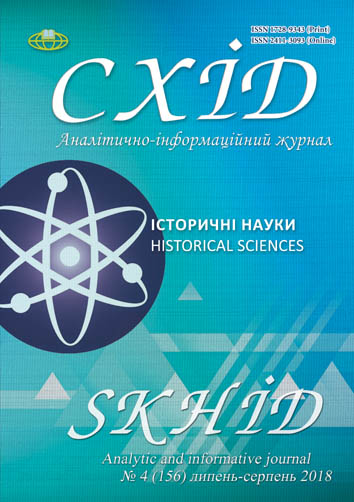Successes and problems of "re-education": to the 70th anniversary of completion of denazification of Germany
DOI:
https://doi.org/10.21847/1728-9343.2018.4(156).143498Keywords:
denazification, "cleaning", nazism, of occupation power, Supervisory council of alliesAbstract
In the article the various social aspects of policy of denazification ofGermanyare probed in 1945-1948, which were stopped up in basis of spiritual and cultural revival of the post-war state. Basic measures and actions of organs of occupation power of allies are examined on "re-education" of Germans after the crash of national socialism and blowing off political and ideological bases of German society of in general.
On the basis of analysis of accessible types of sources the mechanisms of democratization of German society, their successes and failures, are reflected in realization. The social aspects of policy of denazification are analyzed as to the process of ideological transformation of nation. Investigational factors of influence on forming of new socio-cultural reality of post-warGermany. At the use of information of cross-cultural researches the integral frame of society of new post-nationalist socialist Western European country is represented in the conditions of occupation.
It was planned to carry out returning to traditions of democracy by antinazi Germans, catholic and lutheran church, educational establishments, literature, cinema, music, theater on a background adjusting of social and household life of ordinary citizen. The regeneration ofGermanymust was be carried out the method of ideological transformation, licensing and control of Media.
Implement of western democratic catchers in Germany was inculcated unevenly and inconsistently, what counteraction of local population was as a result of. And only after the awareness of occupation power, in particular western areas, minimum intervention from administrations, close cooperation between even subjects, and also gradual transmission to Germans of responsibility for the results of denazification, there was possibility of revival of public life without deepening and complication contradictions which overcame a country in the first post-war years. It allowed solve of that time problems and in a new decade to enter on principles of the realized democracy.Downloads
References
Boyko, M. & Ivanov, O., 2018. Realization politicians of denazification of Germany in the American area of occupation (1945-1949). European historical studios. № 10. С. 63-81. Available at: http://eustudies.history.knu.ua/myhajlo-bojko-oleksandr-ivanov-provedennya-polityky-denatsyfikatsiyi-nimechchyny-v-amerykanskij-zoni-okupatsiyi-1945-1949-rr.pdf (Accessed: 11.08.2018). (ukr).
Bonvec, B., 2017. Double overcoming of the totalitarian past in Germany in 1945 and 1990. Overcoming the past in Germany and Russia: experience and lessons for the future (in memory of Professor A.I. Boroznyak): materials of the International Scientific Conference (February 16-17, 2017, Lipetsk). Lipetsk: LSPU named after P.P. Semenov-Tian-Shansky. P. 96-105. (rus).
Bondar, I. A., 2017. Denazification of Germany in the works of German writers of the XX century. News of higher educational institutions. Problems of polygraphy and publishing. Moscow: Moscow State University of Printing named after Ivan Fyodorov. № 2. P. 59-68. (rus).
Zharonkina, E. A., 2015. The policy of the American military administration on the revival of the cultural and spiritual life of Germany (1945-1949). Herald of the Kemerovo State University. № 3 (63). V.2. Р. 119-123. (rus).
Kosmach, V.A., 2017. Germany and the German question in 1945-1949: pages of history and evaluation of historians: monograph. Vitebsk: VGU named after P.M. Masherov. 338 p. (rus).
Kuhn, G., 2017. Return from the Underworld: the denationalization of post-war Germany. A historian and an artist. № 12. P.41-50. (rus).
Pocheptsov G. Post-war denationalization of Germany as counter propaganda. Available at: https://psyfactor.org/lib/denazification2.htm (Accessed: 02.08.2018). (rus).
Sivachenko, I., 2010. Nurnberg as the place of German collective memory of the Second World War. Ukrainian Historical Collection. V.13. P. 245-251. (ukr).
Directive to the Commander in Chief of the U.S. Occupation Forces (JCS 1067) (April 1945). 1950. United States Department of State, Germany 1947-1949: The Story in Documents. Washington, DC. U.S. Government Printing Office. P. 31-39. (eng).
Dobbins, J., 2008. After the war. Nation-building from FDR to George W. Bush. Santa Monica. 351 р. (eng).
Davidson, E., 1951. The death and life of Germany: An Account of the American Occupation. New York. Alfred Knopf. 456 p. (eng).
Franck, D., 1980. Jahre unseres Lebens. 1945-1949. Reinbek bei Hamburg, Rowohlt Taschenbuch Verlag GmbH. 198 s. (ger).
Heydecker, J., Leeb J., 1979. Der Nürnberger Prozess. Köln: Kiepenheuer, 406 s. (ger).
Haas, S., 1946. Denazifizierung. Gesetz und Verfahren. Heidelberg. Adolf Rausch Verlag. 88 s. Available at: https://dirkdeklein.net/2017/10/02/denazification-a-small-price-to-pay-for-a-genocide. (ger).
Schildt, A. & Siegfried, D., 2009. Deutsche Kulturgeschichte: die Bundesrepublik - 1945-bis zur Gegenwart. Bonn. Bundeszentrale für politische Bildung, 696 s. (ger).
Schullze, E., 1948. Gesetz zur Befreiung von Nationalsozialismus und Militarismus von 1946. München: Biederstein. 427 s. Available at: http://www.rothenburg-unterm-hakenkreuz.de/entnazifizierung-3-grundlage-war-das-gesetz-nr-104-zur-befreiung-von-nationalsozialismus-und-militarismus-von-1946. (ger).
Voigt, T. R., 2000. Denazification in Soviet-occupied Germany. Brandenburg, 1945-1948. Cambridge: Harvard University Press, 336 p. (eng).
Downloads
Published
How to Cite
Issue
Section
License
Copyright (c) 2018 Tetіana Kuprii

This work is licensed under a Creative Commons Attribution-NonCommercial-NoDerivatives 4.0 International License.
1. Authors bear responsibility for the accuracy of facts, quotations, numbers and names used.
2. Manuscripts are not sent back.
3. The publisher does not always agree with the authors' opinion.
4. The authors reserve the right to authorship of the work and pass the first publication right of this work to the journal under the terms of a Creative Commons Attribution-NonCommercial-NoDerivatives 4.0 International License. This license allows others to distribute (copy) the published work for non-commercial purposes, provided there is mandatory attribution to its authors and a link to the first publication in our journal.
5. The authors have the right to conclude separate supplement agreements that relate to non-exclusive work distribution in the form in which it has been published by the journal (for example, to upload the work to the online storage of the journal or publish it as part of a monograph), provided that the reference to the first publication of the work in this journal is included.

